Best Practices: Summercamp 2019
Best Practices under review during the 2019 Summercamp on Bagnowka Jewish Cemetery in Bialystok, Poland.
1: Washing Stones.
Resources from the US National Center for Preservation Technology and Training, regarding the cleaning of tombstones, recommends that stones are washed from bottom to top to avoid the buildup of biologic matter at the bottom while cleaning commences from top to bottom. In addition, the recommendation was forwarded to prewet the stone with a sponge and then use Orvus Quilt/Horse Soap/Shampoo instead of simply water or water with vinegar. Volunteers discovered prewetting the stone allows biologic matter to soften and then rubbing a small amount (quarter-size) of soap directly on the stone rather than diluting a small amount in several gallons of water was more effective than simply washing with water or water and vinegar, requiring less scrubbing. The greatest challenge is still having an adequate water supply on cemetery. This past season, a considerate neighbor adjacent to the cemetery, allowed us to refill containers for a very modest fee. We hope to access city water, located near the main entrance, for next season, understanding there will be a fee for access and water use.
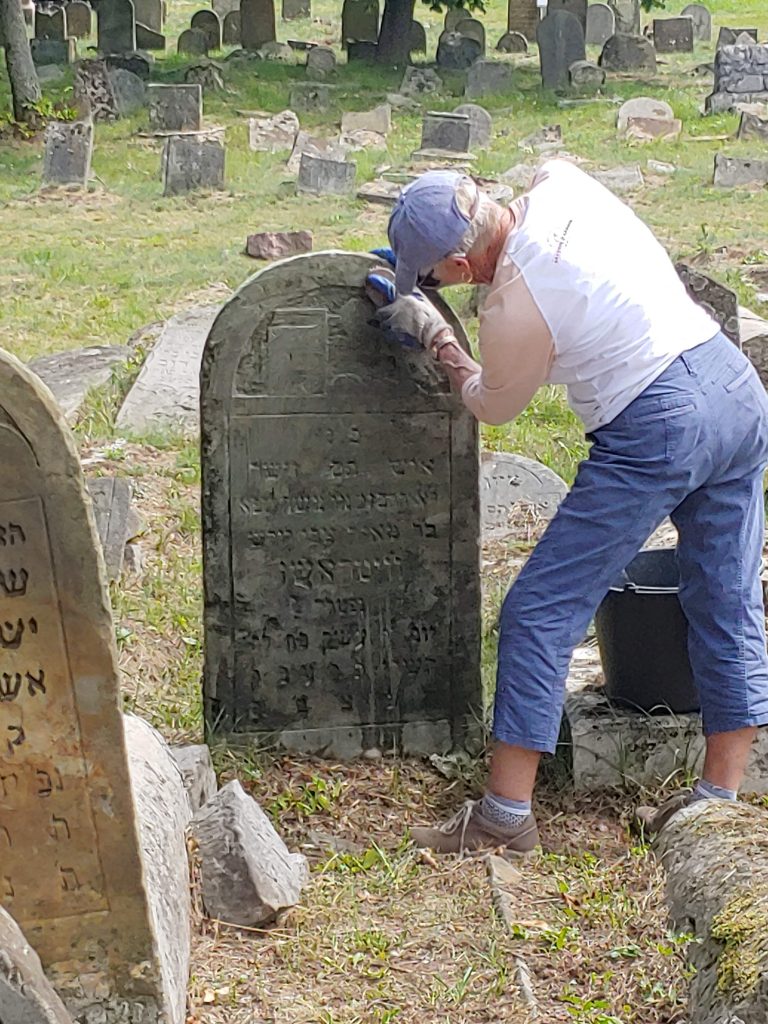
2: Painting Stones.
This year a new paint (Lithichrome) was tested on select granite stones. This oil-based paint is made specifically for mortuary works and should be much more durable than the acrylic paint currently in use. This paint required the occasional addition of paint thinner when temperatures were warmer and the use of face masks, for sensitive volunteers, on days when little wind was present. Volunteers found that the paint applied more easily than the previous acrylic paint, with two thin coats more effective. Inexpensive paint brushes were disposed of rather than cleaned with paint thinner. The best test of the quality of the new oil-based paint will be how it endures over the next year. The acrylic paint was fading in less than four years. Moreover, as more historic photographs of the most traditional Ashkenazi-style tombstones are unexpectedly discovered, we are reexamining how (and whether) these stones should be repainted so as to best respect the funerary tradition still in evidence on Bagnowka Jewish Cemetery. The Ashkenazi-style tombstones were typically painted with a black stain, which permeated the soft sandstone. The inscription was painted in white, with some vital details in gold, and ornamentation of key formulaic components painted in bright colors.
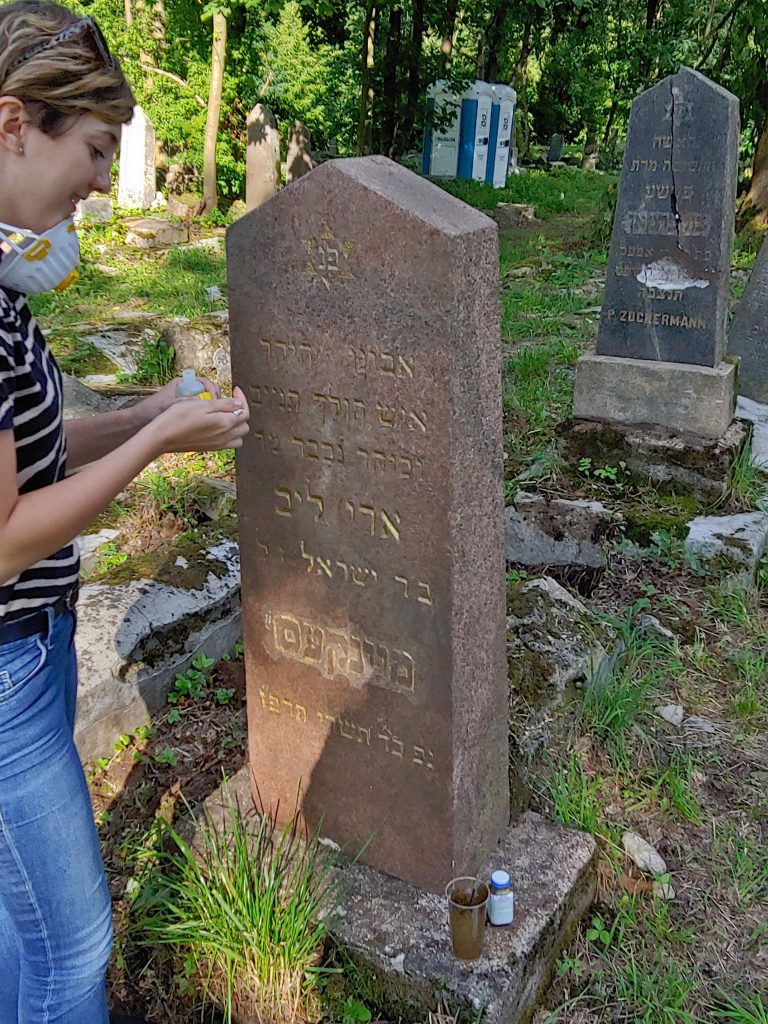
3: Sealing Stones.
This year select stones were chosen to be sealed for specific reasons: 1. to preserve traces of historic black stain or traces of paint most typically on traditional Ashkenazi tombstones; and 2. to protect cleaned Ashkenazi limestone or sandstone tombstones from future biologic growth. The product used was FEDA Impregnat do piaskowca. The rationale behind treating select stones derived from query with Filip Szczepanski as to how we might preserve the traces of black or bright paint on the traditional Ashkenazi tombstones. We also learned that what we assumed was a black paint on such stones was actually a black stain that seeped into the stones, on top of which the inscription was painted in white or gold and, at times, details in the ornamental register were decorated with other bright colors. Four stones were selected: One held traces of a bright orange on the candlesticks and select letters; one tombstone still preserved large areas of black stain; another held an inscription entirely painted in black; and, finally, one stone was beautifully cleaned and free from any dirt or biologic matter. The value of sealing will be evaluated next season. Note: Only the front façade of the stone was sealed to ensure breathability of the stone and avoid pressure fractures or worse when semi-pervious stones expand in the elements.
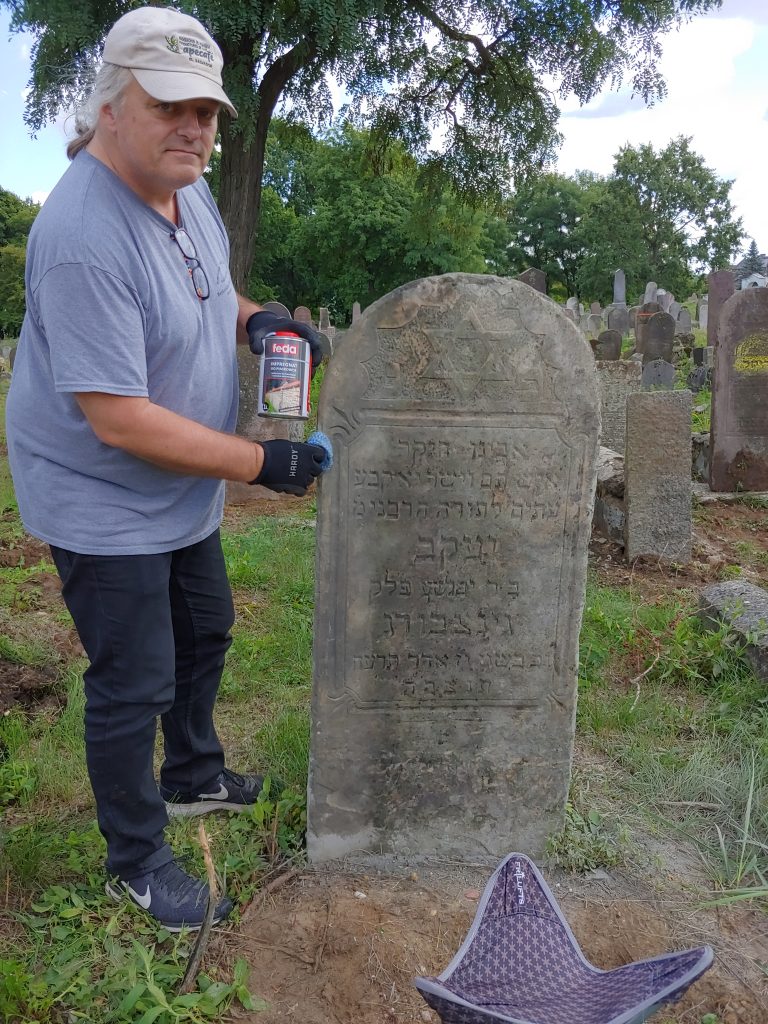
4: Use of Mechanized Equipment
When restoration work was reviewed by Filip Szczepanski of the Rabbinic Commission of Cemeteries, concern was expressed about the depth of disruption to the alleys between sections in the movement of mechanized equipment. A directive was delivered to situate large sheets of marine plywood over alleys to prevent the tracks from disrupting the soil. The crew determined that the placement of plywood would be too cumbersome and time consuming to move from place to place. Rather they adopted a rake and level ground manual methodology, which proved efficient and effective, as well as even more careful planning for the movement of the equipment so as to disturb as little soil in the alleys as possible.
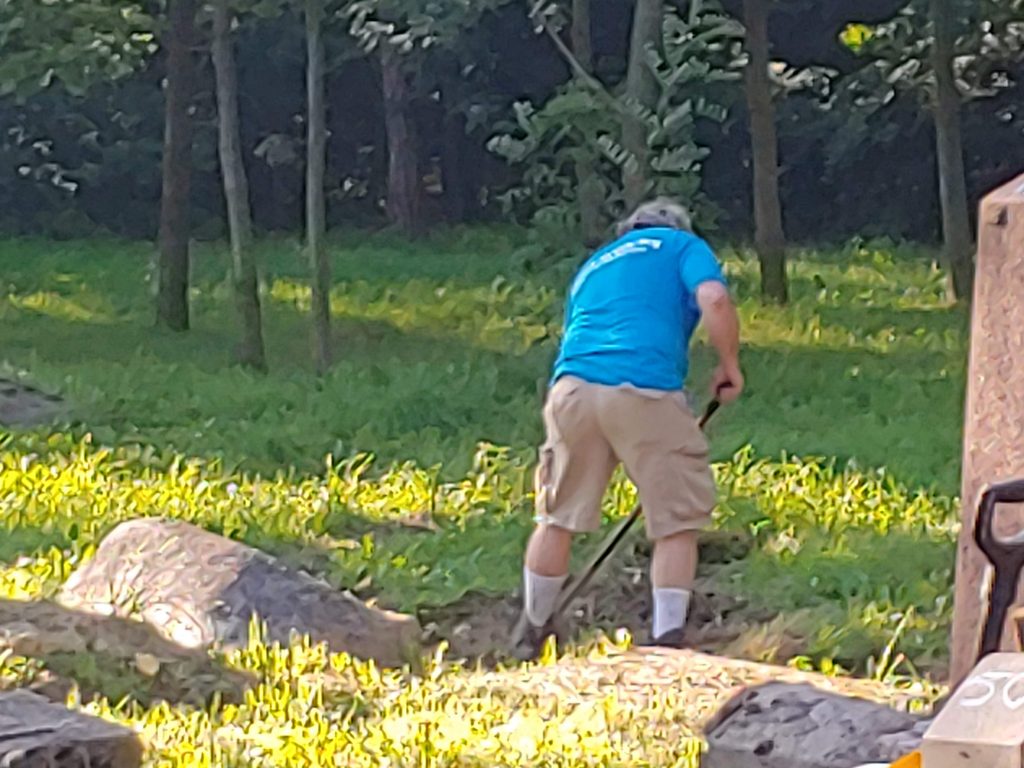
5 Mechanized Equipment vs. Tripod and Pulley
Use of mechanized equipment has tremendously increased the amount and size of stones that can be lifted and reset in a given season. It can, however, only be used as far as the mechanized arm can reach from a given alley. This year, the tripod and pulley device, used until 2016, was reintroduced as a means to lift those stones that remained at the centers of sections rather than procure additional equipment with a longer reach. Work with the tripod and pulley device was focused in two sections in which approximately 25 stones at their centers had been lying recumbent for decades. These stones were successfully lifted and reset over the course of two days, which far exceeded the expectation of the volunteers as compared to use of this system in the past. The greatest concern was properly training volunteers to safely use this system and maintain clear standards of communication both to expedite necessary work and for the safety of participants. This concern will be addressed in the 2020 season.
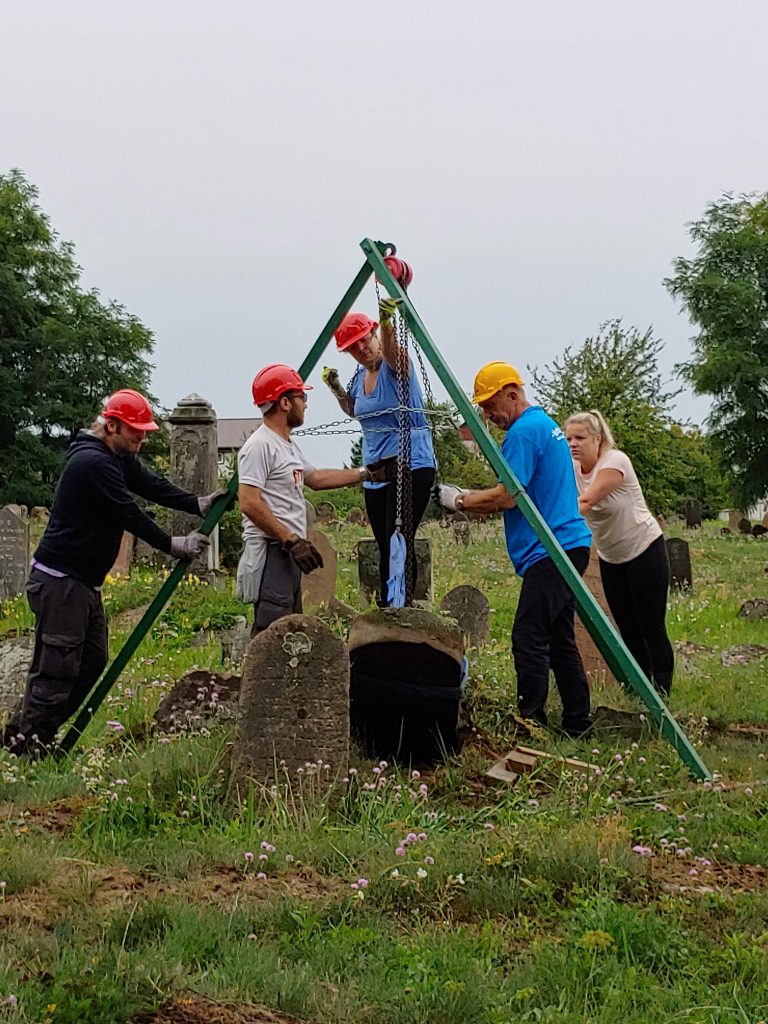
7. Documentation
Given the extensive number of stones now returned to the historic record, recreation of the Bagnowka Burial Registry is possible. A number board that can indicate Section: Row: Plot is used when photographing each stone. An additional photo(s) is also captured without the number board. The greatest concern has also been best time/best sunlight for photographing stones in which the inscription is most legible. On Bagnowka, 300-600pm (1500-1800) is the best opportunity for photographing stones. This time span is, however, insufficient for documenting all necessary stones, which includes those newly uncovered and set as well as past restorations, which now need to be more precisely designated. In addition, a USB Microscope was tested this season to determine if it could assist in deciphering letters/words on stones worn by the elements or crafted from sedimentary stone, which wears unevenly. The USB Microscope was excellent to capture images of paint traces for later analysis but proved inefficient related to both time and what could be viewed.
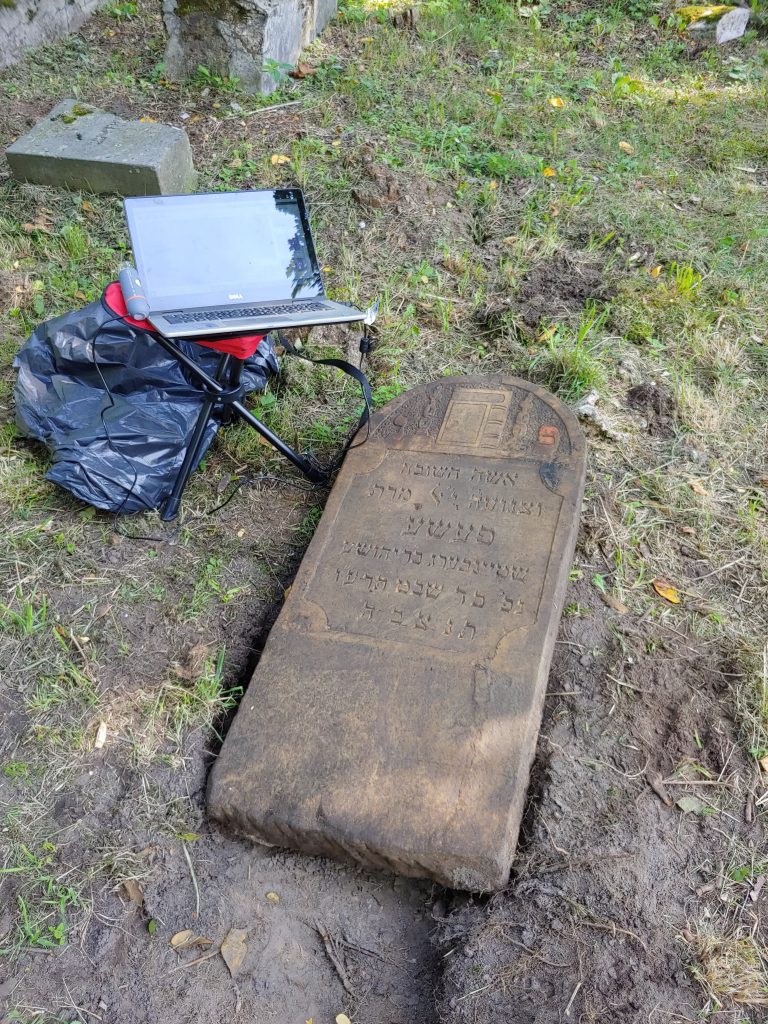
At present, documentation and photographing falls to two people, which generally would be suffic3ient. However, one if not both are frequently called away for other necessary tasks. In the next season, a photographer’s reflective shield will be tested to assist in photographing stones throughout the day, given its ability to direct (sun-)light on a stone’s surface. Moreover, a documentation crew will be established prior to the onset of work with one primary documenter, one primary photographer and one assistant, versed in the basics of photography and with a basic knowledge of Hebrew to assure that documentation and other photographic needs are better achieved. This assistant will also be detached to the machine crew to photograph each new stone soon after it is lifted and washed to assure that no vital details are overlooked.